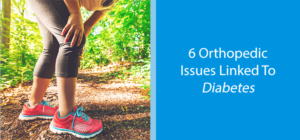
6 Orthopedic Issues Associated With Diabetes
The Endocrine & Skeletal Systems: It’s All Connected. A complex set of systems and processes make the operation of the human body possible. The circulatory, skeletal, nervous, and digestive systems represent just a few of these structures. However, despite their differentiation, these systems do not actually function in an individual bubble. Many, if not most, of these systems work cooperatively to ensure the proper function and survival of the body as a whole. When it comes to diabetes, we often think of this condition as a disease of the endocrine system. This is only natural, as diabetes is directly linked to the pancreas and insulin production or regulation. This one-way thinking can obscure the fuller picture, however, as diabetes can simultaneously affect many different organ systems. Diabetes actually affects several anatomical systems. Yes, the endocrine system is key. Our pancreas—a key player in the endocrine system—regulates the excretion of insulin. But, sugar originates in our digestive system, travelling through the blood (or circulatory system) to deliver energy to the entire body. With the aid of insulin, the pancreas can deliver sugar to energy-needy cells. If our cells don’t receive this energy due to diabetes-related insulin deficiencies, problems can ensue. This is especially true with the skeletal and neurological systems. Diabetes can impact the health and development of our skeletal system and nerves. What we are not completely sure of is the exact reasoning for this relationship. What we do know: diabetes leads to inflammation, nerve damage, and can either accelerate or inhibit bone development and healing. Some clinicians believe that insulin promotes bone growth. For example, too much insulin can lead to too much bone growth, whereas not enough insulin can lead to weakened bones. Researchers also believe that the inflammation caused by diabetes leads to nerve damage, neuropathy, and joint pain. 6 Orthopedic Issues Linked to Diabetes Diabetes-Related Bone Issues Osteoarthritis: Osteoarthritis is a condition characterized by the degeneration of cartilage between the main joints in the body. The primary causes for this degeneration include age-related wear and tear, obesity, and nerve inflammation. Individuals with Type II Diabetes are also prone to obesity and inflammation, which can accelerate the development of symptoms. Osteoporosis: Osteoporosis is a disorder that leads to weakening, fragile bones. Osteoporotic bones can become so fragile that they become porous and actually resemble the structure of a sponge. Individuals with Type I Diabetes have been shown to have an increased co-occurrence of osteoporosis due to a lack of insulin to promote bone development. DISH: Diffuse Idiopathic Skeletal Hyperostosis (DISH), also called Forestier’s disease, results in a hardening of the connective tissues. This can lead to pain, stiffness and immobility, especially in the spine. Again, this hardening is most often found in those with Type II Diabetes and can be attributed to insulin-related bone growth. Increased Risk for Fractures: With osteoporosis, neuropathy, and the development of hardened ligaments, the potential for falls increases substantially. This can increase susceptibility to fractures, especially in the hips and joints of


